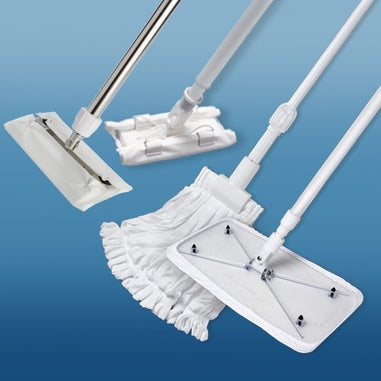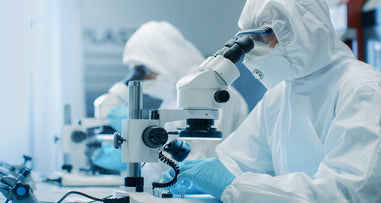- No products in the cart.
Maintaining a clean room can be tricky and expensive. There are many factors to consider, but often it comes down to one key factor: the operator. The behavior of operators in the cleanroom is critical – correct usage of appropriate equipment can keep a cleanroom functioning efficiently, but the operators themselves are also the largest source of contamination. Therefore, it’s critical that operators always follow best practices and use cleanroom equipment appropriately.
Cleanroom Environment

Cleanroom Operators At Work
Here we outline a quick how-to for basic cleanroom operating procedures. Major sources of excessive cleanroom operating costs are operator re-work and poor access to necessary supplies. While working in a cleanroom, every action can introduce millions of particles to the environment, and designing your operating procedures to minimize these actions is key to decrease your cleanroom operating costs.
1. Design your cleanroom carefully
Cleanroom design and floor plan determine the long-term effectiveness and ease-of-use of your facility. Many factors should be taken into consideration at this step including airflow, particle management, and room pressures. Care should be taken to follow guidelines as recommended per the classification of your cleanroom to ensure compliance and efficiency.
2. Don and remove apparel with care
In addition to internal gowning procedures, many cleanrooms require operators to change their clothes prior to donning cleanroom apparel. Changing from ‘street clothes’ into fresh ‘building clothes’ (often made of 100% polyester) can reduce outside particles that could enter the cleanroom. Select your garment system in line with requirements per your cleanroom classification. In addition, operators must remove any hair gel, aromatic perfume, makeup, etc. to reduce contamination risk. Ultimately, gowning procedures start at home with good hygiene.
Although cleanroom practices will differ, appropriate gowning often follows this basic sequence:
Donning Sequence
-
Wash and dry hands.
-
Don bouffant to contain all hair.
-
Remove excess soil from shoes on tacky mat.
-
Don disposable shoe covers.
-
Don first set of gloves.
-
Move to gowning area.
-
Don hood. Touch only inside of the hood.
-
Completely cover bouffant with hood.
-
Don facemask.
-
Don coverall. Do not let it touch the floor or walls. Seal appropriately.
-
Don boots. Seal appropriately.
-
Don goggles or face shield.
-
Either remove first set of gloves or put a second pair over the first pair. Seal by rolling gloves over cuffs of coverall sleeves.
The removal sequence should essentially be followed in reverse, in the gowning area.
3. Carefully control your actions in the cleanroom
As mentioned earlier, the behavior of the operator is both the key to good cleanroom practice and also the largest source of contamination. Therefore, operators should be hired and trained to keep best cleanroom practices in mind. Successful operators often display careful actions, good hygiene, and meticulous planning. While in the cleanroom, any action taken by the operator can produce millions of particles, so care must be taken to limit movements, talking, and actions to those strictly necessary to manufacture the product. Additional considerations for optimal cleanroom practice include keeping all doors closed during operation, prohibiting all personal items, restraining from touching or scratching, and restricting individuals that exhibit symptoms of illness.
4. Know your supplies and how to store them
Cleanroom garments and operator-related consumables can be stored in the gowning area. Before entering cleanroom areas, all supplies from outside should be wiped down and decontaminated appropriately. Any supplies for cleanroom usage, including chemicals and supplies for cleaning, should be stored in cleanroom packaging until use. Store a small excess of critical supplies to ensure that operators can always access what they need without delays in production. Keep in mind that it is not recommended to store equipment and supplies in areas with unidirectional, vertical airflow to decrease risk of particle contamination.
5. Maintain your cleanroom meticulously
Follow the housekeeping instructions outlined per your classification of cleanroom. Establish a standard operating procedure for cleanroom housekeeping and ensure documentation. Select cleaning materials and equipment appropriate for your cleanroom type (i.e. not all cleanrooms require aseptic agents). Continue to audit and monitor adherence to all cleanroom protocols to ensure that all personnel are aware of standard practice. Document as much as possible to create a written record. Be sure to only use cleanroom-compatible paper, pens, and other materials. Tracking this data is critical to uncover shifts in practices that can be addressed before compromising the entire cleanroom.
In summary, by optimizing your cleanroom workflow you reduce cleanroom operating costs and decrease contamination risk to keep production continuing efficiently. Keep supplies accessible, train operators to be meticulous in their movements, and follow best practices.
__
For over 40 years, Lab Pro has been committed to delivering a complete laboratory solution by offering the highest quality products, chemicals, reagents, microscopes and imaging equipment for our customers worldwide. Come visit the biggest Lab Supply showroom in the Bay Area, or contact us online or at 888-452-2776 to discover how to decrease your cleanroom operating costs with the right equipment.












































